|
|
Created/dedicated as per personal communication with Don Muse, April 2007
Updated as per James P. Tuttle's The Hawk Moths of North America, April 2010
Updated as per personal communication with Terri McLaughlin (Pachysphinx occidentalis, Washoe Valley, June 20, 2012); June 21, 2012
Updated as per personal communication with Kristie Parker (Paonias myops male, Verdi Hydro Plant, July 15, 2014); July 20, 2014
Updated as per personal communication with Jason Naylor (Smerinthus ophthalmica, Reno, May 2, 2015); May 2, 2015
Updated as per personal communication with K F Otto (Pachysphinx occidentalis, Cold Spring Valley, Washoe County, July 14, 2018); July 15, 2018
|
Washoe County, Nevada
Sphingidae
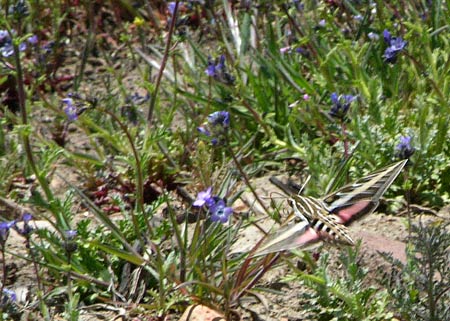
Hyles lineata, nectaring at Sierra gentian, courtesy of Don Muse
This site has been created by Bill Oehlke.
Comments, suggestions and/or additional information/sightings are welcomed by Bill.
This page is inspired by and dedicated to Don Muse of the Sierra foothills in Reno, Nevada (Washoe County).
Don writes (April 9, 2007):
"The moth was obtaining nectar from the little blue ground cover flower (probably Gentianopsis holopetala = Sierra gentian).
This was taken in about 2003 on an eastern Sierra foothill during a lovely spring season."
Eighteen Sphingidae species are listed for Nevada on the U.S.G.S. website. Not all of the species are reported or anticipated in Washoe County (Five are reported on
U.S.G.S.: Big poplar sphinx (Pachysphinx occidentalis), One-eyed sphinx (Smerinthus cerisyi), Small-eyed sphinx (Paonias myops),
White-lined sphinx (Hyles lineata) and Clark's sphinx (Proserpinus clarkiae)).
It is hoped that this checklist, with the thumbnails and notes, will help you quickly identify the moths you are likely to encounter.
A "WO" after the species name indicates that I (William Oehlke) expect that this moth is present or
might be present, although unreported.
A "USGS" indicates the moth is confirmed on USGS site. The USGS site has now been replaced by BAMONA, an excellent online resource.
Please help me develop this list with improved, documented accuracy by sending sightings (species, date, location), preferably with an
electronic image, via email to Bill Oehlke.
Many thanks also to Terri McLaughlin who sends the Pachysphinx occidentalis image below.
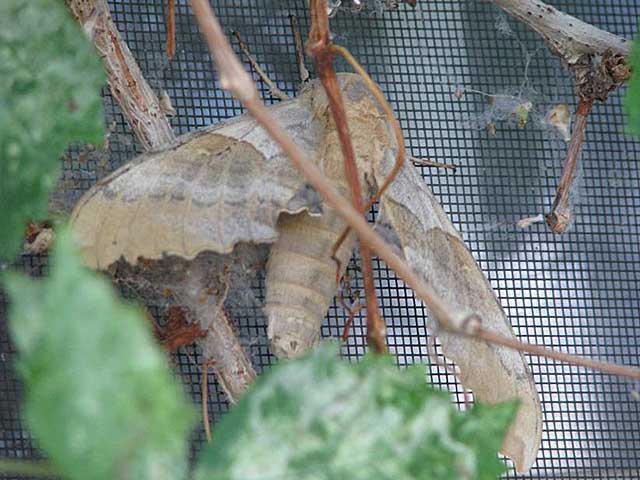
Pachysphinx occidentalis, Washoe Valley, Washoe County, Nevada,
June 20, 2012, courtesy of Terri McLaughlin.
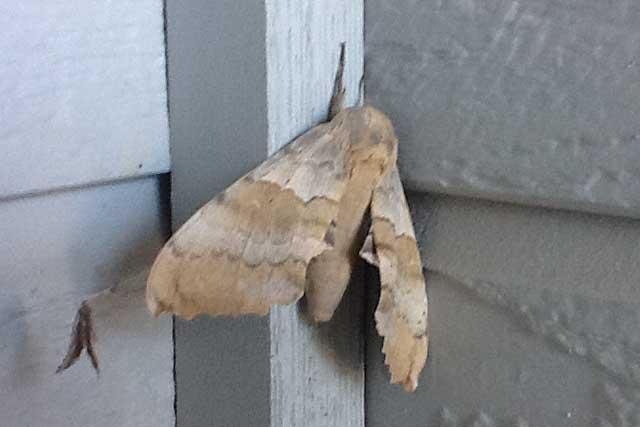
Pachysphinx occidentalis, Reno, Washoe County, Nevada,
July 10, 2012, courtesy of Tim (Trooper?).
Many thanks to Kristie Parker who provides the following image of Paonias myops.
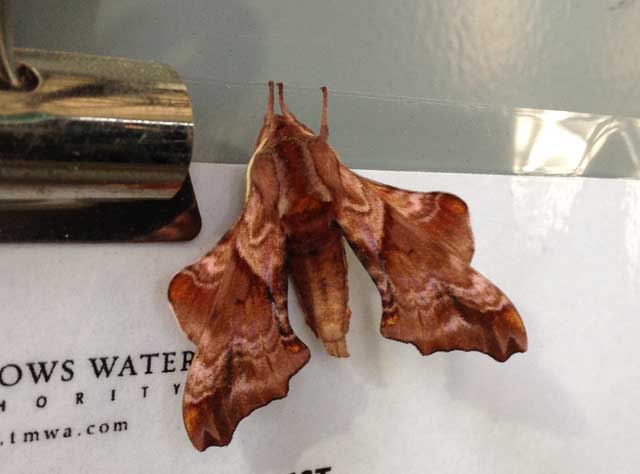
Paonias myops male, Verdi Hydro Plant, Washoe County, Nevada,
July 15, 2014, courtesy of Kristie Parker.
Many thanks to Jason Naylor who provides the following image of Smerinthus ophthalmica.
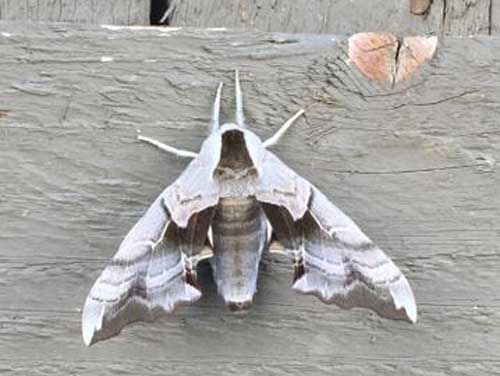
Smerinthus ophthalmica, Reno, Washoe County, Nevada,
May 2, 2015, courtesy of Jason Naylor.
Many thanks to Kenji Otto who provides the folowing image of Pachysphinx occidentalis.
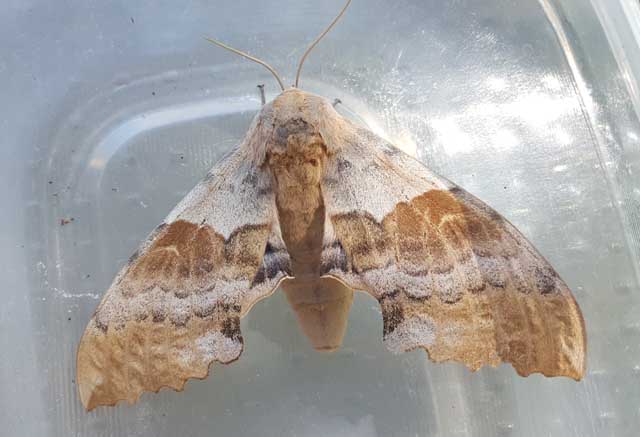
Pachysphinx occidentalis, Cold Spring Valley, Washoe County, Nevada,
July 14, 2018, courtesy of K F Otto.
Visit Nevada Catocala: Underwing Moths.
Visit Clark County Sphingidae Larvae for Sphingidae larvae (caterpillars) expected in Nevada.
If you are travelling outside the state or country, visit Sphingidae of the Americas: pictoral checklists for all USA states,
all Canadian provinces, Mexico and all coutries in Central and South America.
Sphinginae subfamily
Sphingini tribe:
 |
Agrius cingulata
WO; unlikely:
This species has not been reported in Washoe County, but may be
there as a very rare stray. The moth is a very
strong flier and is frequently encountered far north of its usual range.
|
 |
Manduca quinquemaculatus
WO, the Five-spotted Hawkmoth:
This large bodied moth flies in tobacco fields and vegetable gardens
(potatoes, tomatoes) and wherever host plants are found. |
 |
Manduca sexta
WO, unlikely, the Carolina Sphinx:
This species is not recorded in Washoe
County.
however, if you grow tomatoes, you may have encountered it.
Larvae get very large and can strip a tomato plant. |
 |
Sphinx chersis
WO, unlikely, the Northern Ash Sphinx or Great Ash Sphinx:
The upperside of the forewing is soft dark-gray to blue-gray with a series of black dashes, one reaching the wing tip. Note grey
thorax with narrow black lines.
|
 |
Sphinx drupiferarum
WO, the Wild Cherry Sphinx:
Forewings, long and slender, are held close to the body when the moth is at rest.
I only see them occasionally on P.E.I. despite visiting lights
frequently. Hence they may be present, but seldom seen. |
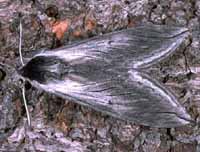 |
Sphinx perelegans
WO, taken 3 miles west in Placer Co., CA., the Elegant Sphinx:
Sphinx perelegans adults fly in montane woodlands and mixed chaparral-type vegetation as a single brood
in the north, with adults mainly on the wing in June and July.
It flies from dusk until after midnight. Note dark thorax. |
 |
Sphinx vashti
WO, the Snowberry Sphinx:
The upperside of the forewing has a narrow black subterminal line
bordered by a white inverted V-shaped line on the outside, and a
black line running inwards from the apex of the wing.
It is most often found in montane woodlands and along streamcourses.
|
Smerinthini Tribe:
 |
Pachysphinx occidentalis
USGS/TM/KFO,
the Big Poplar Sphinx:
This one is quite similar to Pachysphinx modesta, with modesta
being smaller and darker.
Moths should be on the wing from June-August.
|
Pachysphinx occidentalis, Washoe Valley, June 20, 2012, courtesy of Terri McLaughlin.
Pachysphinx occidentalis, Cold Spring Valley, July 14, 2018, courtesy of Kenji Otto.
 |
Paonias myops USGS/KP,
the Small-eyed Sphinx: This small species is present in Washoe County. This species ranges across North America.
The hindwings have a small blue eyespot ringed with black on a yellow background.
|
Paonias myops male, Verdi Hydro Plant, July 15, 2014, Kristie Parker
 |
Smerinthus cerisyi
USGS, the Cerisyi's
Sphinx or One-eyed Sphinx, Larvae feed on poplars and willows.
Flight would be from late May-July as a single brood.
|
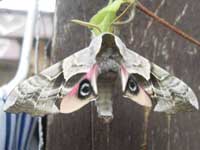 |
Smerinthus ophthalmica
MPNw/JN Larvae feed on poplars, aspen and willows.
Note different shape of double arced forewing pm line compared to the straighter pm line of cerisyi, directly above.
S. ophthalmica has smoother scalloping of the fw outer margin. Note dark crescent topped patch along inner margin, extending in an arc toward the body.
|
Smerinthus ophthalmica, Reno, May 2, 2015, Jason Naylor.
Macroglossinae subfamily
Dilophonotini Tribe:
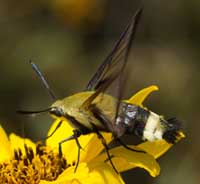 |
Hemaris thetis WO, the Thetis Clearwing or Bee Hawk Moth,
The moth flies along forest edges and in meadows, gardens and
brushy fields. Day-flying adults nectar at lantana, dwarf bush honeysuckle,
snowberry, orange hawkweed, thistles, lilac, Canada violet, etc.
|
Philampelini Tribe:
 |
Eumorpha achemon
WO, unlikely,
the Achemon Sphinx:
Adults nectar from flowers of Japanese honeysuckle
(Lonicera japonica), petunia (Petunia hybrida),
mock orange (Philadelphus coronarius), and phlox (Phlox).
Fight would be from June to August. Larvae feed on grape foliage. |
Macroglossini Tribe:
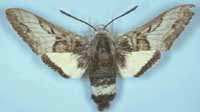 |
Euproserpinus wiesti
WO, Wiest's Primrose Sphinx:
Euproserpinus wiesti adults fly, during the day, over sand washes and prairie blow-outs as a single brood from May-June.
|
 |
Hyles lineata
USGS/DM, the White-lined Sphinx:
Adults usually fly at dusk, during the night, at dawn, and during the
day. Moths nectar at a number of different flowers and oviposit on
Epilobium cana (California fuchsia) and
Hooker's Evening Primrose. |
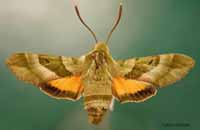 |
Proserpinus clarkiae
USGS, Clark's Sphinx:
Adults fly in the afternoon from April-June in oak woodland and
pine-oak woodland in foothills, nectaring from chia, heartleaf
milkweed, golden currant, bluedicks, fairyfans, vetches,
thistles, hedgenettles, etc. |
|
|
Enjoy some of nature's wonderments, giant silk moth cocoons.
These cocoons are for sale winter and fall. Beautiful Saturniidae moths will emerge the following spring and summer.
Read Actias luna rearing article.
Additional online help available.
Eggs of many North American species are offered during the spring and summer. Occasionally
summer Actias luna and summer Antheraea polyphemus cocoons are available. Shipping to US destinations is done
from with in the US.
Use your browser "Back" button to return to the previous page.
This page is brought to you by Bill Oehlke and the WLSS.
Pages are on space rented from Bizland. If you would like to become a "Patron of the Sphingidae Site", contact Bill.
Please send sightings/images to Bill. I will do my best to respond to requests for identification help.
 | 
Show appreciation for this site by clicking on flashing butterfly to the left.
The link will take you to a page with links to many insect sites. |







